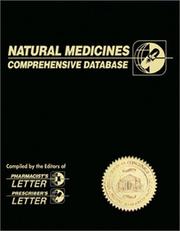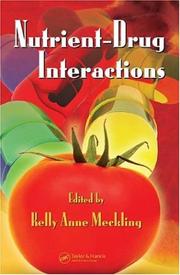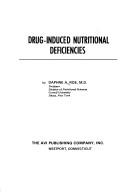| Listing 1 - 10 of 12 | << page >> |
Sort by
|
Book
Abstract | Keywords | Export | Availability | Bookmark
 Loading...
Loading...Choose an application
- Reference Manager
- EndNote
- RefWorks (Direct export to RefWorks)
Le traitement par antagonistes de la vitamine K (AVK) est responsable de 12% des accidents hémorragiques d’origine iatrogène. Il est indispensable pour le médecin de connaître le métabolisme, le mécanisme d’action et les variations génétiques liés à la prise de ces médicaments mais aussi les techniques pour l’initiation et l’équilibration du traitement. On insistera sur les interactions liées aux AVK, la prise en charge des personnes âgées et, des grossesses, sur la démarche lors d’une intervention ou lors d’un surdosage.

ISBN: 0967613647 Year: 2000 Publisher: Stockton : Therapeutic Research Faculty,
Abstract | Keywords | Export | Availability | Bookmark
 Loading...
Loading...Choose an application
- Reference Manager
- EndNote
- RefWorks (Direct export to RefWorks)
Dietary Supplements. --- Drug Interactions. --- Food-drug interactions --- Herbal medicine --- Plants, medicinal --- Food-drug interactions --- Herbal medicine --- Plants, medicinal
Book
Year: 2017 Publisher: Bruxelles: UCL. Faculté de pharmacie et des sciences biomédicales,
Abstract | Keywords | Export | Availability | Bookmark
 Loading...
Loading...Choose an application
- Reference Manager
- EndNote
- RefWorks (Direct export to RefWorks)
It is nowadays well known that grapefruit is a CYP 3A4 enzyme inhibitor. But what about clinical practice? As grapefruit has a significant impact on the pharmacokinetics of some drugs, like felodipine, one can wonder about the ubiquity of this interaction. It is essential for a healthcare professional to be able to advise patients about consumption of this fruit: in which case is it a forbidden fruit, in which case is it a harmless one? This final thesis aims to demystify the underlying mechanisms of pharmacokinetic interactions caused by grapefruit. In this bibliographic research, intrinsic properties of grapefruit will be evaluated to bring out populations most at risk of interaction with grapefruit. Afterwards, an analysis of pharmacokinetic grapefruit interactions mechanisms will follow. Those data will then allow us, with scientific knowledge and case reports, to assess the clinical relevance of grapefruit interactions with important drugs in modern medicine. Finally, clinical perspectives will be suggested, highlighting the potential benefits brought by grapefruit-drug interactions. The main goals of this final thesis are the instruction of the reader about potential interactions caused by grapefruit and sensitization of healthcare professionals about potential effects of food on drugs pharmacokinetics. Il est désormais bien connu que le pamplemousse est un inhibiteur enzymatique du CYP 3A4. Mais qu’en est-il en pratique clinique ? En effet, si le pamplemousse exerce un impact significatif sur la pharmacocinétique de certains médicaments tels que la felodipine, on peut s’interroger quant à l’ubiquité de cette interaction. Il est essentiel pour un professionnel pouvoir conseiller les patients quant à la consommation de ce fruit : dans quel cas est-ce un fruit interdit, dans quel cas est-ce un fruit inoffensif ? C’est pourquoi, ce mémoire vise à démystifier les mécanismes régissant les interactions pharmacocinétiques produites par le pamplemousse. Au cours de ce travail de recherche bibliographique, les propriétés intrinsèques du pamplemousse seront évaluées, afin de mettre en évidence les populations à risque d’interaction avec le pamplemousse. Par la suite, une analyse de mécanismes pharmacocinétiques d’interaction sera réalisée. Ces données permettront ensuite, sur base de données scientifiques et de rapport de cas, d’évaluer la relevance clinique d’interactions avec le pamplemousse et de médicaments importants dans notre médecine moderne. Enfin, il sera proposé quelques perspectives cliniques mettant en avant les bénéfices potentiels que peut apporter l’interaction du pamplemousse avec un principe actif. Les objectifs finaux de ce mémoire sont l’instruction du lecteur sur les interactions potentielles provoquées par le pamplemousse et la sensibilisation des professionnels de la santé sur les effets éventuels de l’alimentation sur la pharmacocinétique d’un traitement médicamenteux.
Citrus paradisi --- Cytochrome P-450 Enzyme System --- Risk Assessment --- Food-Drug Interactions
Book
Year: 2009 Publisher: Bruxelles: UCL,
Abstract | Keywords | Export | Availability | Bookmark
 Loading...
Loading...Choose an application
- Reference Manager
- EndNote
- RefWorks (Direct export to RefWorks)
There are not studies about herb-drug interactions despite the widespread use of herbal medicines. There are several qualities of “natural” products which contain different amounts of herbal active constituents. There is no process for systematic evaluation of botanical supplement products for possible interactions with prescription medications. That’s why, the study of the interactions between these products and the drugs were difficult. In the literature, there are two types of interactions between plants and drugs which are described. On the one hand, pharmacodynamic interactions occur when the pharmacological action of the plant cause an increase or a decrease in the pharmacological action of the drug. On the other hand, pharmacokinetic interactions occur when vegetable component is responsible for the changes in absorption, metabolism or elimination of the drug.
Clinically important interactions appear to involve effects on drug metabolism via cytochromes P450 isonzymes. We will study clinically significant herb-drug predictions of interactions were confirmed in vivo whereas others weren’t. So, it is important to promote the notification of all suspect interactions in order to prevent side effects in a better way. Continued education if consumers and healthcare professionals about the potential herb-drug interactions is required to ensure further interactions that do not occur Les produits à base de plantes ne font pas l’objet d’études approfondies qui permettraient une connaissance des interactions avec les médicaments. Il existe plusieurs conditionnements de produits «naturels» à base de plantes avec des teneurs en substances actives différentes. Ces produits « naturels » ne subissent pas des contrôles de qualité aussi rigoureux que les médicaments. C’est pourquoi, l’étude des interactions entre ces produits et les médicaments a été difficile. Dans la littérature, il existe deux types d’interactions entre plantes et médicaments qui sont décrits. D’une part, les interactions d’ordre pharmacodynamique sont observées quand l’action pharmacologique de la plante a pour effet d’augmenter ou de diminuer l’action pharmacologique du médicament en agissant a niveau des récepteurs. D’autre part, les interactions d’ordre pharmacocinétique sont observées lorsqu’un constituant végétal est responsable des changements au niveau de l’absorption, du métabolisme ou de l’élimination du médicament. Les principales interactions pharmacocinétiques revêtant d’une importance clinique seront dues aux variations d’activités enzymatiques des CYP450 induites par la présence d’inducteur ou d’inhibiteur au sein de la plante. Ce travail a pour objet l’étude des interactions entre les produits à base de plantes non médicamenteux et les médicaments au niveau des CYP450. Nous verrons que certaines prédictions d’interactions ont été confirmées in vivo alors que d’autres pas. Il est donc important d’encourager le rapportage de tous les cas « suspects » d’interactions afin de mieux prévenir les effets secondaires. La vigilance s’impose surtout avec els médicaments à faible index thérapeutique. Lors de la délivrance de médicaments, le pharmacien jour un rôle essentiel dans le conseil et la prévention des interactions.
Drug Interactions --- Herb-Drug Interactions --- Cytochrome P-450 Enzyme System --- Food-Drug Interactions
Book
ISBN: 9782804193973 2804193977 Year: 2016 Publisher: Louvain-la-Neuve : De Boeck Supérieur,
Abstract | Keywords | Export | Availability | Bookmark
 Loading...
Loading...Choose an application
- Reference Manager
- EndNote
- RefWorks (Direct export to RefWorks)
Drug interactions --- Geneesmiddelen -- Wisselwerking --- Interactions médicamenteuses --- Medicaments -- Interactions --- Drug Interactions --- Herb-drug interactions --- Food-drug interactions --- Antagonisme médicamenteux --- Interaction médicaments-plantes --- Médicaments --- Interaction --- Aliments --- Handbooks, manuals, etc. --- Guides, manuels, etc --- Interactions médicamenteuses --- Drug Interactions. --- Antagonisme médicamenteux. --- Interaction médicaments-plantes. --- Aliments. --- Herb-Drug Interactions. --- Food-Drug Interactions. --- Food-Drug Interactions

ISBN: 9781574449150 157444915X Year: 2007 Volume: 7 Publisher: Boca Raton : CRC/Taylor & Francis,
Abstract | Keywords | Export | Availability | Bookmark
 Loading...
Loading...Choose an application
- Reference Manager
- EndNote
- RefWorks (Direct export to RefWorks)
Food-Drug Interactions. --- Drug Interactions. --- Nutrition --- Diet Therapy. --- Metabolism --- Plants, Medicinal --- Drug-nutrient interactions. --- Interactions médicaments-aliments --- drug effects. --- metabolism.
Book
ISBN: 9782716317870 Year: 2022 Publisher: Paris : Dauphin Éditions,
Abstract | Keywords | Export | Availability | Bookmark
 Loading...
Loading...Choose an application
- Reference Manager
- EndNote
- RefWorks (Direct export to RefWorks)
Destiné aux professionnels de la santé, ce guide d'information décrit les effets indésirables et les interactions des médicaments, des compléments alimentaires et des produits de santé naturels.
Herb-Drug Interactions --- Food-Drug Interactions --- Pharmacology. --- Médicaments --- Interaction médicaments-plantes. --- Pharmacologie. --- Interactions médicamenteuses. --- Interactions aliments-médicaments. --- Interactions médicaments-plantes. --- Pharmacologie. --- Interaction --- Aliments.
Book
ISBN: 1603273611 1603273638 9786612833359 160327362X 1282833359 Year: 2010 Publisher: New York, NY : Humana Press,
Abstract | Keywords | Export | Availability | Bookmark
 Loading...
Loading...Choose an application
- Reference Manager
- EndNote
- RefWorks (Direct export to RefWorks)
Handbook of Drug-Nutrient Interactions, Second Edition is an essential new work that provides a scientific look behind many drug-nutrient interactions, examines their relevance, offers recommendations, and suggests research questions to be explored. In the five years since publication of the first edition of the Handbook of Drug-Nutrient Interactions new perspectives have emerged and new data have been generated on the subject matter. Providing both the scientific basis and clinical relevance with appropriate recommendations for many interactions, the topic of drug-nutrient interactions is significant for clinicians and researchers alike. For clinicians in particular, the book offers a guide for understanding, identifying or predicting, and ultimately preventing or managing drug-nutrient interactions to optimize patient care. Divided into six sections, all chapters have been revised or are new to this edition. Chapters balance the most technical information with practical discussions and include outlines that reflect the content; discussion questions that can guide the reader to the critical areas covered in each chapter, complete definitions of terms with the abbreviation fully defined and consistent use of terms between chapters. The editors have performed an outstanding service to clinical pharmacology and pharmaco-nutrition by bringing together a multi-disciplinary group of authors. Handbook of Drug-Nutrient Interactions, Second Edition is a comprehensive up-to-date text for the total management of patients on drug and/or nutrition therapy but also an insight into the recent developments in drug-nutrition interactions which will act as a reliable reference for clinicians and students for many years to come.
Chemistry. --- Drug-nutrient interactions -- Handbooks, manuals, etc. --- Food-Drug Interactions -- Handbooks. --- Nutrition. --- Nutritional Physiological Phenomena -- Handbooks. --- Nutritional Physiological Phenomena. --- Toxicology. --- Drug-nutrient interactions --- Drug Interactions --- Physiological Phenomena --- Food-Drug Interactions --- Nutritional Physiological Phenomena --- Phenomena and Processes --- Pharmacological Processes --- Physiological Processes --- Pharmacological Phenomena --- Health & Biological Sciences --- Biology --- Pharmacy, Therapeutics, & Pharmacology --- Biophysics --- Pharmacology. --- Pharmacology/Toxicology. --- Chemicals --- Medicine --- Pharmacology --- Poisoning --- Poisons --- Alimentation --- Food --- Nutrition --- Health --- Physiology --- Diet --- Dietetics --- Digestion --- Food habits --- Malnutrition --- Toxicology --- Health aspects --- Nutrition . --- Drug effects --- Medical pharmacology --- Medical sciences --- Chemotherapy --- Drugs --- Pharmacy --- Physiological effect

ISBN: 0870552058 Year: 1976 Publisher: Westport (Conn.): Avi
Abstract | Keywords | Export | Availability | Bookmark
 Loading...
Loading...Choose an application
- Reference Manager
- EndNote
- RefWorks (Direct export to RefWorks)
Avitaminosis --- Drug-nutrient interactions --- Drugs --- Nutrition disorders --- Diet-drug interactions --- Drug-diet interactions --- Drug-food interactions --- Food-drug interactions --- Interactions, Drug-nutrient --- Nutrient-drug interactions --- Disorders of nutrition --- Adverse drug reactions --- Adverse reactions to drug therapy --- Chemotherapy --- Drug-induced disease --- Drug side effects --- Side effects of drugs --- Hypovitaminosis --- Vitamin deficiency --- Etiology --- Side effects --- Complications --- Adverse reactions --- Toxicology --- Pharmacology. Therapy --- Pathology of the metabolism --- Diseases --- Iatrogenic diseases --- Drug interactions --- Deficiency diseases --- Vitamins --- Metabolism --- Nutrition --- Physiological effect
Book
Year: 2021 Publisher: Basel, Switzerland MDPI - Multidisciplinary Digital Publishing Institute
Abstract | Keywords | Export | Availability | Bookmark
 Loading...
Loading...Choose an application
- Reference Manager
- EndNote
- RefWorks (Direct export to RefWorks)
This book serves to highlight the pharmacokinetics/drug–drug interactions and mechanistic understanding in relation to the drug-metabolizing enzymes and drug transporters.This book presents a series of drug metabolism and transport mechanisms that govern the pharmacokinetic features of therapeutic drugs as well as natural herbal medicines. It also covers the pharmacokinetic interactions caused by inhibiting or inducing the metabolic or transport activities under disease states or the coadministration of potential inhibitors. It also deals with microenvironmental pharmacokinetic profiles as well as population pharmacokinetics, which gives new insights regarding the pharmacokinetic features with regard to drug metabolism and transporters.
Medicine --- Pharmaceutical industries --- tofacitinib --- dose-dependent pharmacokinetics --- hepatic and intestinal first-pass effect --- rats --- catalposide --- in vitro human metabolism --- UDP-glucuronosyltransferase --- sulfotransferase --- carboxylesterase --- celecoxib --- drug–drug interaction --- fluorescence --- HPLC --- metabolism --- repaglinide --- HSG4112 --- anti-obesity agent --- stereoselectivity --- pharmacokinetics --- compound K --- protopanaxadiol (PPD) --- biliary excretion --- intestinal metabolism --- Carthamus tinctorius extract --- notoginseng total saponins --- comparative pharmacokinetic study --- large volume direct injection --- compatibility mechanism --- mertansine --- human hepatocytes --- cytochrome P450 --- UDP-glucuronosyltransferases --- sodium-glucose cotransporter 2 (SGLT2) inhibitors --- DWP16001 --- kidney distribution --- inhibition mode --- diabetes --- transporter-enzyme interplay --- influx transporter --- efflux transporter --- physiologically based pharmacokinetic model --- cytochrome P450 enzymes --- tiropramide --- healthy Korean subjects --- modeling --- population pharmacokinetic --- quercetin --- breast cancer resistance protein --- inhibitor --- prazosin --- sulfasalazine --- kinetic analysis --- food–drug interactions --- Caco-2 --- EpiIntestinal --- first-pass --- P-gp --- BCRP --- drug transporter --- CYP3A4 --- oral availability --- automatization --- drug absorption --- drug dosing --- head-and-neck cancer --- real-time measurements --- taxanes --- tissue engineering --- UHPLC-MS/MS --- metformin --- verapamil --- drug interaction --- organic cation transporter 2 --- renal excretion --- acute renal failure --- gentamicin --- cisplatin --- hepatic CYP3A1(23) --- creatinine clearance --- renal clearance --- nonrenal clearance --- tofacitinib --- dose-dependent pharmacokinetics --- hepatic and intestinal first-pass effect --- rats --- catalposide --- in vitro human metabolism --- UDP-glucuronosyltransferase --- sulfotransferase --- carboxylesterase --- celecoxib --- drug–drug interaction --- fluorescence --- HPLC --- metabolism --- repaglinide --- HSG4112 --- anti-obesity agent --- stereoselectivity --- pharmacokinetics --- compound K --- protopanaxadiol (PPD) --- biliary excretion --- intestinal metabolism --- Carthamus tinctorius extract --- notoginseng total saponins --- comparative pharmacokinetic study --- large volume direct injection --- compatibility mechanism --- mertansine --- human hepatocytes --- cytochrome P450 --- UDP-glucuronosyltransferases --- sodium-glucose cotransporter 2 (SGLT2) inhibitors --- DWP16001 --- kidney distribution --- inhibition mode --- diabetes --- transporter-enzyme interplay --- influx transporter --- efflux transporter --- physiologically based pharmacokinetic model --- cytochrome P450 enzymes --- tiropramide --- healthy Korean subjects --- modeling --- population pharmacokinetic --- quercetin --- breast cancer resistance protein --- inhibitor --- prazosin --- sulfasalazine --- kinetic analysis --- food–drug interactions --- Caco-2 --- EpiIntestinal --- first-pass --- P-gp --- BCRP --- drug transporter --- CYP3A4 --- oral availability --- automatization --- drug absorption --- drug dosing --- head-and-neck cancer --- real-time measurements --- taxanes --- tissue engineering --- UHPLC-MS/MS --- metformin --- verapamil --- drug interaction --- organic cation transporter 2 --- renal excretion --- acute renal failure --- gentamicin --- cisplatin --- hepatic CYP3A1(23) --- creatinine clearance --- renal clearance --- nonrenal clearance
| Listing 1 - 10 of 12 | << page >> |
Sort by
|

 Search
Search Feedback
Feedback About UniCat
About UniCat  Help
Help News
News